完整版克鲁格曼国际经济学第十版重点笔记
克鲁格曼《国际经济学》笔记和课后习题详解(长期价格水平和汇率)【圣才出品】
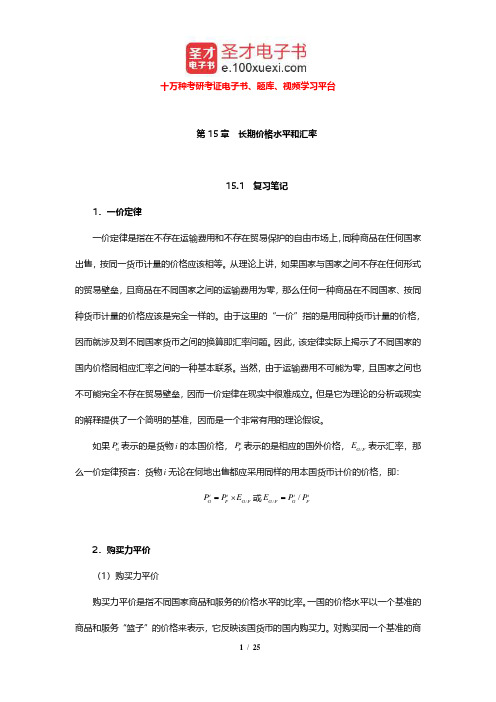
十万种考研考证电子书、题库、视频学习平台第15章 长期价格水平和汇率15.1 复习笔记1.一价定律一价定律是指在不存在运输费用和不存在贸易保护的自由市场上,同种商品在任何国家出售,按同一货币计量的价格应该相等。
从理论上讲,如果国家与国家之间不存在任何形式的贸易壁垒,且商品在不同国家之间的运输费用为零,那么任何一种商品在不同国家、按同种货币计量的价格应该是完全一样的。
由于这里的“一价”指的是用同种货币计量的价格,因而就涉及到不同国家货币之间的换算即汇率问题。
因此,该定律实际上揭示了不同国家的国内价格同相应汇率之间的一种基本联系。
当然,由于运输费用不可能为零,且国家之间也不可能完全不存在贸易壁垒,因而一价定律在现实中很难成立。
但是它为理论的分析或现实的解释提供了一个简明的基准,因而是一个非常有用的理论假设。
如果i G P 表示的是货物i 的本国价格,i F P 表示的是相应的国外价格,/G F E 表示汇率,那么一价定律预言:货物i 无论在何地出售都应采用同样的用本国货币计价的价格,即:/i i G F G F P P E =⨯或//i i G F G F E P P =2.购买力平价(1)购买力平价购买力平价是指不同国家商品和服务的价格水平的比率。
一国的价格水平以一个基准的商品和服务“篮子”的价格来表示,它反映该国货币的国内购买力。
对购买同一个基准的商十万种考研考证电子书、题库、视频学习平台品和服务“篮子”来说,在本国以本国货币支付的价格与其在外国以外国货币支付的价格之比,便是购买力平价。
具体计算方法为:在两国(或多国)选择同质的“一篮子”商品和服务,收集价格、数量和支出额资料,分别核算各组、各类商品和服务价格的比率,最终获得一个综合的价格比率。
(2)购买力平价和一价定律之间的关系购买力平价和一价定律之间区别在于:一价定律适用于单个商品的情况,而购买力平价理论则适用于普遍的价格水平,即商品篮子中所有基准商品价格的组合。
克鲁格曼《国际经济学》笔记和课后习题详解(发展中国家的贸易政策)【圣才出品】

十万种考研考证电子书、题库、视频学习平台第10章发展中国家的贸易政策10.1 复习笔记1.进口替代战略(1)含义及特征进口替代战略又称内向型发展战略,其基本特征是以国内生产的工业制成品代替进口品,满足国内需求,并以此带动国民经济增长。
(2)一般做法①首先发展相对简易的日用工业,然后发展重化工业。
②压缩政府的不必要开支,增加生产性投资比重。
③对建立替代工业所必须的机器设备、中间品或原料进口采取关税减免和政府补贴的优惠政策。
④通过关税、非关税壁垒以及高估本国币值的方式,限制一般工业品进口,同时保证资本品以较低价格进口。
(3)幼稚工业论(幼稚工业论是进口替代战略的指导思想)①含义发展中国家具有制造业的潜在的比较优势,但发展中国家新建的制造工业最初却不能与发达国家已经成熟完善的制造业竞争。
为了使新成长的制造业获得立足之地,政府应该暂时地给予支持,直到它们足够强大,能够参与国际竞争为止。
②注意之处十万种考研考证电子书、题库、视频学习平台a.试图从现在就进入未来才会具有比较优势的产业,并不总能得到好处。
b.如果政府保护本身有助于培养制造业的竞争力,那么保护才是值得的。
反之,则不值得。
总之,只有存在某种国内市场失灵的情况下,幼稚工业论才能成为政府干预的有效论据。
③市场失灵幼稚工业是否需要保护取决于幼稚工业的保护必须与一种具体的市场失灵相联系,这种市场失灵会使得私有市场不能以应有的速度发展这一产业。
有两种类型的市场失灵可以作为保护幼稚工业的依据:不完全资本市场和无偿占用问题。
a.不完全资本市场作为保护幼稚工业的依据认为,如果一个发展中国家没有一整套金融机构可以使得传统部门的储蓄用于新成长部门的投资,那么新工业部门的增长将会受这些工业当前盈利能力的限制。
最优政策是建立更完善的资本市场。
但是,由于对这些幼稚工业的保护可以提高利润,从而使其更快成长,所以保护幼稚工业可以作为次优的政策选择。
b.无偿占用问题的思想是:新产业产生的社会福利没有得到补偿。
克鲁格曼 国际经济学第10版 英文答案 国际金融部分krugman_intlecon10_im_14_GE
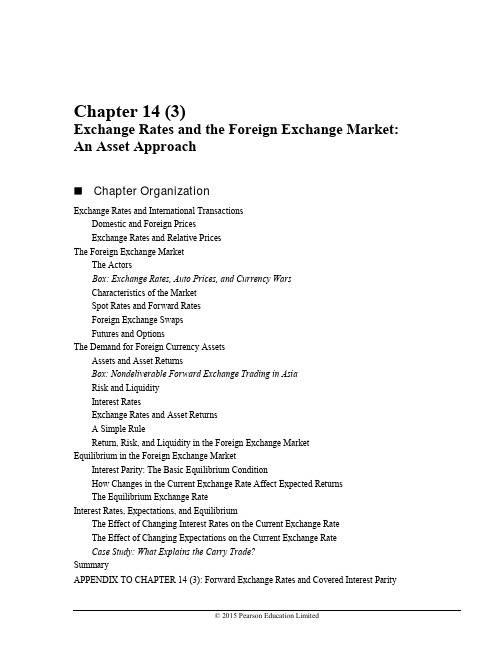
Chapter 14 (3)Exchange Rates and the Foreign Exchange Market: An Asset ApproachChapter OrganizationExchange Rates and International TransactionsDomestic and Foreign PricesExchange Rates and Relative PricesThe Foreign Exchange MarketThe ActorsBox: Exchange Rates, Auto Prices, and Currency WarsCharacteristics of the MarketSpot Rates and Forward RatesForeign Exchange SwapsFutures and OptionsThe Demand for Foreign Currency AssetsAssets and Asset ReturnsBox: Nondeliverable Forward Exchange Trading in AsiaRisk and LiquidityInterest RatesExchange Rates and Asset ReturnsA Simple RuleReturn, Risk, and Liquidity in the Foreign Exchange MarketEquilibrium in the Foreign Exchange MarketInterest Parity: The Basic Equilibrium ConditionHow Changes in the Current Exchange Rate Affect Expected ReturnsThe Equilibrium Exchange RateInterest Rates, Expectations, and EquilibriumThe Effect of Changing Interest Rates on the Current Exchange RateThe Effect of Changing Expectations on the Current Exchange RateCase Study: What Explains the Carry Trade?SummaryAPPENDIX TO CHAPTER 14 (3): Forward Exchange Rates and Covered Interest Parity© 2015 Pearson Education LimitedChapter OverviewThe purpose of this chapter is to show the importance of the exchange rate in translating foreign prices into domestic values as well as to begin the presentation of exchange rate determination. Central to the treatment of exchange rate determination is the insight that exchange rates are determined in the same way a s other asset prices. The chapter begins by describing how the relative prices of different countries’ goods are affected by exchange rate changes. This discussion illustrates the central importance of exchange rates for cross-border economic linkages. The determination of the level of the exchange rate is modeled in the context of the exchange rate’s role as the relative price of foreign and domestic currencies, using the uncovered interest parity relationship.The euro is used often in examples. Some students may not be familiar with the currency or aware of which countries use it; a brief discussion may be warranted. A full treatment of EMU and the theories surrounding currency unification appears in Chapter 20(9).The description of the foreign exchange market stresses the involvement of large organizations (commercial banks, corporations, nonbank financial institutions, and central banks) and the highly integrated natureof the market. The nature of the foreign exchange market ensures that arbitrage occurs quickly so that common rates are offered worldwide. A comparison of the trading volume in foreign exchange markets to that in other markets is useful to underscore how quickly price arbitrage occurs and equilibrium is restored. Forward foreign exchange trading, foreign exchange futures contracts, and foreign exchange options play an important part in currency market activity. The use of these financial instruments to eliminate short-run exchange rate risk is described.The explanation of exchange rate determination in this chapter emphasizes the modern view that exchange rates move to equilibrate asset markets. The foreign exchange demand and supply curves that introduce exchange rate determination in most undergraduate texts are not found here. Instead, there is a discussion of asset pricing and the determination of expected rates of return on assets denominated in different currencies.Students may already be familiar with the distinction between real and nominal returns. The text demonstrates that nominal returns are sufficient for comparing the attractiveness of different assets. There is a brief description of the role played by risk and liquidity in asset demand, but these considerations are not pursued in this chapter. (The role of risk is taken up again in Chapter 18[7].)Substantial space is devoted to the topic of comparing expected returns on assets denominated in domestic and foreign currency. The text identifies two parts of the expected return on a foreign currency asset (measured in domestic currency terms): the interest payment and the change in the value of the foreign currency relative to the domestic currency over the period in which the asset is held. The expected return on a foreign asset is calculated as a function of the current exchange rate for given expected values of the future exchange rate and the foreign interest rate.The absence of risk and liquidity considerations implies that the expected returns on all assets traded in the foreign exchange market must be equal. It is thus a short step from calculations of expected returns on foreign assets to the interest parity condition. The foreign exchange market is shown to be in equilibrium only when the interest parity condition holds. Thus, for given interest rates and given expectations about future exchange rates, interest parity determines the current equilibrium exchange rate. The interest parity diagram introduced here is instrumental in later chapters in which a more general model is presented. Because a command of this interest parity diagram is an important building block for future work, we recommend drills that employ this diagram.The result that a dollar appreciation makes foreign currency assets more attractive may appear counterintuitive to students—why does a stronger dollar reduce the expected return on dollar assets? The key to explaining this point is that, under the static expectations and constant interest rates assumptions, a dollar appreciation today implies a greater future dollar depreciation; so, an American investor can expect to gain not only theChapter 14Exchange Rates and the Foreign Exchange Market: An Asset Approach 77© 2015 Pearson Education Limitedforeign interest payment but also the extra return due to the dollar’s additional future depreciation. The following diagram illustrates this point. In this diagram, the exchange rate at time t + 1 is expected to be equal to E . If the exchange rate at time t is also E , then expected depreciation is 0. If, however, the exchange rate depreciates at time t to E ', then it must appreciate to reach E at time t + 1. If the exchange rate appreciates today to E ", then it must depreciate to reach E at time t + 1. Thus, under static expectations, a depreciation today implies an expected appreciation and vice versa.Figure 14(3)-1This pedagogical tool can be employed to provide some further intuition behind the interest parityrelationship. Suppose that the domestic and foreign interest rates are equal. Interest parity then requires that the expected depreciation is equal to zero and that the exchange rate today and next period is equal to E . If the domestic interest rate rises, people will want to hold more domestic currency deposits. The resulting increased demand for domestic currency drives up the price of domestic currency, causing the exchange rate to appreciate. How long will this continue? The answer is that the appreciation of the domestic currency continues until the expected depreciation that is a consequence of the domestic currency’s appreciation today just offsets the interest differential.The text presents exercises on the effects of changes in interest rates and of changes in expectations of the future exchange rate. These exercises can help develop students’ intuition. For example, the initial result of a rise in U.S. interest rates is a higher demand for dollar-denominated assets and thus an increase in the price of the dollar. This dollar appreciation is large enough that the subsequent expected dollar depreciation just equalizes the expected return on foreign currency assets (measured in dollar terms) and the higher dollar interest rate.The chapter concludes with a case study looking at a situation in which interest rate parity may not hold: the carry trade. In a carry trade, investors borrow money in low-interest currencies and buy high-interest-rate currencies, often earning profits over long periods of time. However, this transaction carries an element of risk as the high-interest-rate currency may experience an abrupt crash in value. The case study discusses a popular carry trade in which investors borrowed low-interest-rate Japanese yen to purchase high-interest-rate Australian dollars. Investors earned high returns until 2008, when the Australian dollar abruptly crashed, losing 40 percent of its value. This was an especially large loss as the crash occurred amidst a financial crisis in which liquidity was highly valued. Thus, when we factor in this additional risk of the carry trade, interest rate parity may still hold.The Appendix describes the covered interest parity relationship and applies it to explain the determination of forward rates under risk neutrality as well as the high correlation between movements in spot and forward rates.Answers to Textbook Problems1. At an exchange rate of 1.05 $ per euro, a 5 euro bratwurst costs 1.05$/euro ⨯ 5 euros = $5.25. Thus,the bratwurst in Munich is $1.25 more expensive than the hot dog in Boston. The relative price is $5.25/$4 = 1.31. A bratwurst costs 1.31 hot dogs. If the dollar depreciates to 1.25$/euro, the bratwurst now costs 1.25$/euro ⨯ 5 euros = $6.25, for a relative price of $6.25/$4 = 1.56. You have to give up1.56 hot dogs to buy a bratwurst. Hot dogs have become relatively cheaper than bratwurst after thedepreciation of the dollar.2. If it were cheaper to buy Israeli shekels with Swiss francs that were purchased with dollars than todirectly buy shekels with dollars, then people would act upon this arbitrage opportunity. The demand for Swiss francs from people who hold dollars would rise, causing the Swiss franc to rise in value against the dollar. The Swiss franc would appreciate against the dollar until the price of a shekel would be exactly the same whether it was purchased directly with dollars or indirectly through Swiss francs.3. Take for example the exchange rate between the Argentine peso, the US dollar, the euro, and theBritish pound. One dollar is worth 5.3015 pesos, while a euro is worth 7.0089 pesos. To rule out triangular arbitrage, we need to see how many pesos you would get if you first bought euros with your dollars (at an exchange rate of 0.7564 euros per dollar), then used these euros to buy pesos. In other words, we need to compute E D = E EUR/USD × E ARG/EUR = 0.7564× 7.0089 = 5.3015 pesos per dollar. This is almost exactly (with rounding) equal to the direct rate of pesos per dollar.Following the same procedure for the British pound yields a similar result.We need to say that triangular arbitrage is “approximately” ruled out for several reasons. First,rounding error means that there may be some small discrepancies between the direct and indirect exchange rates we calculate. Second, transactions costs on trading currencies will prevent complete arbitrage from occurring. That said, the massive volume of currencies traded make these transactions costs relatively small, leading to “near” perfect arbitrage.4. A depreciation of Chinese yuan makes the import more expensive. Since the demand for oil isinelastic, China needs to import oil from the oil exporting countries. This leads to spending more on oil when the exchange rate falls in value. This can cause the balance of payment to worsen in the short run. Hence, a depreciation of domestic currency may or may not have a favourable impact on the balance of payment in the short run.5. The dollar rates of return are as follows:a. ($250,000 - $200,000)/$200,000 = 0.25.b. ($275 - $255)/$255 = 0.08.c. There are two parts to this return. One is the loss involved due to the appreciation of the dollar;the dollar appreciation is ($1.38 - $1.50)/$1.50 =-0.08. The other part of the return is the interest paid by the London bank on the deposit, 10 percent. (The size of the deposit is immaterial to thecalculation of the rate of return.) In terms of dollars, the realized return on the London depositis thus 2 percent per year.。
克鲁格曼《国际经济学》笔记和课后习题详解(国民收入核算与国际收支平衡)【圣才出品】

克鲁格曼《国际经济学》笔记和课后习题详解(国民收⼊核算与国际收⽀平衡)【圣才出品】⼗万种考研考证电⼦书、题库、视频学习平台第12章国民收⼊核算与国际收⽀平衡12.1 复习笔记1.国民收⼊账户(1)GNP宏观经济分析的主要着眼点是⼀国的国民⽣产总值(GNP),它是⼀国的⽣产要素在⼀定时期内所⽣产并在市场上卖出的最终商品和服务的价值总量。
GNP是宏观经济学家研究⼀国产出时所⽤的基本度量⼿段,由花费在最终产品上的⽀出的市场价值量加总⽽得到。
GNP的⽀出与劳动、资本以及其他⽣产要素紧密相连。
根据购买最终产品的四种可能⽤途,GNP可以分解为以下四个部分:消费(国内居民私⼈消费的数额)、投资(私⼈企业为进⾏再⽣产⽽留下的⽤于购买⼚房设备的数额)、政府购买(政府使⽤的数额)和经常项⽬余额(对外净出⼝的商品和服务的数额)。
(2)国民收⼊国民收⼊等于GNP减去折旧,加上净单边转移⽀付,再减去间接商业税。
即:国民收⼊=GNP-折旧+净单边转移⽀付-间接商业税在实际经济中,要使GNP和国民收⼊的恒等关系完全成⽴,必须对GNP的定义作⼀定调整:①GNP不考虑机器和建筑物在使⽤过程中由于磨损⽽引起的经济损失。
这部分经济损失称为折旧,折旧减少了资本所有者的收⼊。
为了计算⼀定时期的国民收⼊,必须从GNP 中减去这⼀时期资本的折旧。
GNP减去折旧后称为国民⽣产净值(NNP)。
⼗万种考研考证电⼦书、题库、视频学习平台②⼀国的收⼊可能会包括外国居民的赠与,这种赠与称为单边转移⽀付。
单边转移⽀付的例⼦包括向居住在国外的退休公民⽀付养⽼⾦、赔偿⽀付和对遭受旱灾国家的救济援助等。
净单边转移⽀付是⼀国收⼊的⼀部分,但不是⼀国产出的⼀部分,因此,净单边转移⽀付,必须加到NNP中以计算国民收⼊。
③国民收⼊取决于⽣产者获得的产品价格,GNP则取决于购买者所⽀付的价格。
但是,这两组价格并不是完全⼀致的,例如,销售税会使得购买者的⽀付⼤于销售者的收⼊,导致GNP被⾼估,超过了国民收⼊。
(完整版)克鲁格曼国际经济学第十版重点笔记
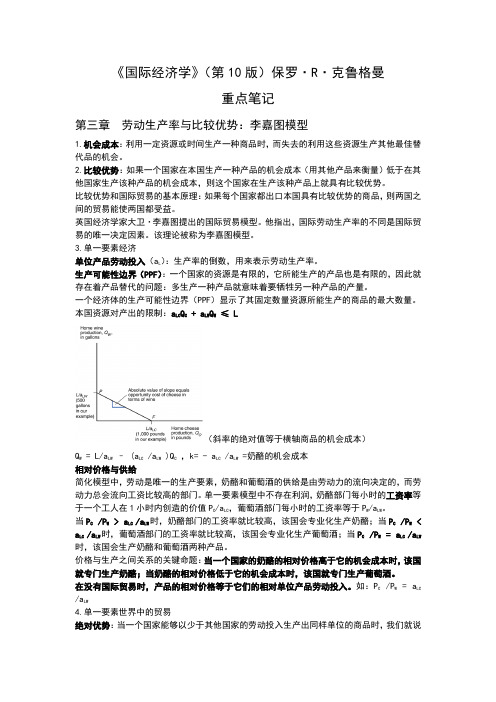
《国际经济学》(第10版)保罗·R·克鲁格曼重点笔记第三章劳动生产率与比较优势:李嘉图模型1.机会成本:利用一定资源或时间生产一种商品时,而失去的利用这些资源生产其他最佳替代品的机会。
2.比较优势:如果一个国家在本国生产一种产品的机会成本(用其他产品来衡量)低于在其他国家生产该种产品的机会成本,则这个国家在生产该种产品上就具有比较优势。
比较优势和国际贸易的基本原理:如果每个国家都出口本国具有比较优势的商品,则两国之间的贸易能使两国都受益。
英国经济学家大卫·李嘉图提出的国际贸易模型。
他指出,国际劳动生产率的不同是国际贸易的唯一决定因素。
该理论被称为李嘉图模型。
3.单一要素经济单位产品劳动投入(a L):生产率的倒数,用来表示劳动生产率。
生产可能性边界(PPF):一个国家的资源是有限的,它所能生产的产品也是有限的,因此就存在着产品替代的问题:多生产一种产品就意味着要牺牲另一种产品的产量。
一个经济体的生产可能性边界(PPF)显示了其固定数量资源所能生产的商品的最大数量。
本国资源对产出的限制:a LC Q C + a LW Q W≤ L(斜率的绝对值等于横轴商品的机会成本)Q W = L/a LW– (a LC /a LW )Q C,k= - a LC /a LW =奶酪的机会成本相对价格与供给简化模型中,劳动是唯一的生产要素,奶酪和葡萄酒的供给是由劳动力的流向决定的,而劳动力总会流向工资比较高的部门。
单一要素模型中不存在利润,奶酪部门每小时的工资率等于一个工人在1小时内创造的价值P C/a LC,葡萄酒部门每小时的工资率等于P W/a LW。
当P C /P W > a LC /a LW时,奶酪部门的工资率就比较高,该国会专业化生产奶酪;当P C /P W < a LC /a LW时,葡萄酒部门的工资率就比较高,该国会专业化生产葡萄酒;当P C /P W = a LC /a LW 时,该国会生产奶酪和葡萄酒两种产品。
克鲁格曼国贸理论第十版课后习题集答案解析CH04
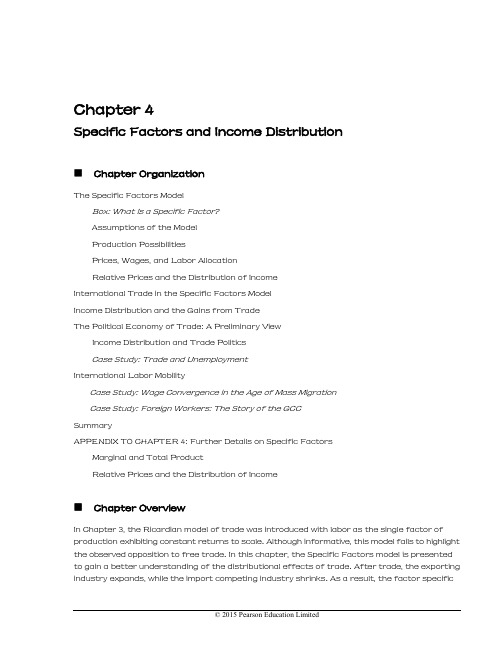
Chapter 4Specific Factors and Income Distribution⏹Chapter OrganizationThe Specific Factors ModelBox: What Is a Specific Factor?Assumptions of the ModelProduction PossibilitiesPrices, Wages, and Labor AllocationRelative Prices and the Distribution of IncomeInternational Trade in the Specific Factors ModelIncome Distribution and the Gains from TradeThe Political Economy of Trade: A Preliminary ViewIncome Distribution and Trade PoliticsCase Study: Trade and UnemploymentInternational Labor MobilityCase Study: Wage Convergence in the Age of Mass MigrationCase Study: Foreign Workers: The Story of the GCCSummaryAPPENDIX TO CHAPTER 4: Further Details on Specific FactorsMarginal and Total ProductRelative Prices and the Distribution of Income⏹Chapter OverviewIn Chapter 3, the Ricardian model of trade was introduced with labor as the single factor of production exhibiting constant returns to scale. Although informative, this model fails to highlight the observed opposition to free trade. In this chapter, the Specific Factors model is presented to gain a better understanding of the distributional effects of trade. After trade, the exporting industry expands, while the import competing industry shrinks. As a result, the factor specific© 2015 Pearson Education Limitedto the exporting industry gains from trade, while the factor specific to the import competing industry loses from trade. However, the aggregate gains from trade are greater than the losses.The Specific Factors model assumes that there is one factor that is mobile between sectors (commonly thought of as labor) and production factors that are specific to each sector. The chapter begins with a simple economy producing two goods: cloth and food. Cloth is produced using labor and its specific factor, capital. Food is produced using labor and its specific factor, land. Given that capital and labor are specific to their respective industries, the mix of goods produced by a country is determined by share of labor employed in each industry. The key difference between the Ricardian model and the Specific Factors model is that in the latter, there are diminishing returns to labor. For example, production of food will increase as labor is added, but given a fixed amount of land, each additional worker will add less and less to food production.As we assume that labor is perfectly mobile between industries, the wage rate must be identical between industries. With competitive labor markets, the wage must be equal to the price of each good times the marginal product of labor in that sector. We can use the common wage rate to show that the economy will produce a mix of goods such that the relative price of one good in terms of the other is equal to the relative cost of that good in terms of the other. Thus, an increase in the relative price of one good will cause the economy to shift its production toward that good.With international trade, the country will export the good whose relative price is below the world relative price. The world relative price may differ from the domestic price before trade for two reasons. First, as in the Ricardian model, countries differ in their production technologies. Second, countries differ in terms of their endowments of the factors specific to each industry. After trade, the domestic relative price will equal the world relative price. As a result, the relative price in the exporting sector will rise, and the relative price in the import competing sector will fall. This will lead to an expansion in the export sector and a contraction of the import competing sector.Suppose that after trade, the relative price of cloth increases by 10 percent. As a result, the country will increase production of cloth. This will lead to a less than 10 percent increase in the wage rate because some workers will move from the food to the cloth industry. The real wage paid to workers in terms of cloth (w/P C) will fall, while the real wage paid in terms of food (w/P F) will rise. The net welfare effect for labor is ambiguous and depends on relative preferences for cloth and food. Owners of capital will unambiguously gain because they pay their workers a lower real wage, while owners of land will unambiguously lose as they now face higher costs. Thus, trade benefits the factor specific to the exporting sector, hurts the factor specific to the import competing sector, and has ambiguous effects on the mobile factor. Despite these asymmetric effects of trade, the overall effect of trade is a net gain. Stated differently, it is theoretically possible to redistribute the gains from trade to those who were hurt by trade and make everyone better off than they were before trade.Given these positive net welfare effects, why is there such opposition to free trade? To answer© 2015 Pearson Education LimitedChapter 4 Specific Factors and Income Distribution 15this question, the chapter looks at the political economy of protectionism. The basic intuition is that the though the total gains exceed the losses from trade, the losses from trade tend to be concentrated, while the gains are diffused. Import tariffs on sugar in the United States are used to illustrate this dynamic. It is estimated that sugar tariffs cost the average person $7 per year. Added up across all people, this is a very large loss from protectionism, but the individual losses are not large enough to induce people to lobby for an end to these tariffs. However, the gains from protectionism are concentrated among a small number of sugar producers, who are able to effectively coordinate and lobby for continued protection. When the losses from trade are concentrated among politically influential groups, import tariffs are likely to be seen. Ohio, a key swing state in U.S. presidential elections and a major producer of both steel and tires, is used as an example to illustrate this point with both Presidents Bush and Obama supporting tariffs on steel and tires, respectively.Although the losers from trade are often able to successfully lobby for protectionism, the chapter highlights three reasons why this is an inefficient method of limiting the losses from trade. First, the actual impact of trade on unemployment is fairly low, with estimates of only 2.5 percent of unemployment directly attributable to international trade. Second, the losses from trade are driven by one industry expanding at the expense of another. This phenomenon is not specific to international trade and is also seen with changing preferences or new technology. Why should policy be singled out to protect people hurt by trade and not for those hurt by these other trends? Finally, it is more efficient to help those hurt by trade—by redistributing the gains from trade in the form of safety nets for those temporarily unemployed and worker retraining programs to ease the transition from import competing to export sectors—than it is to limit trade to protect existing jobs.Finally, the chapter uses the framework of the Specific Factors model to analyze the distributional effects of international labor migration. With free migration of labor across borders, wages must equalize among countries. Workers will migrate from low-wage countries to high-wage countries. As a result, wages in the low-wage countries will rise, and those in the high-wage countries will fall. Though the net effect of free migration is positive, there will be both winners and losers from migration. Workers who stayed behind in the low-wage country will benefit, as will owners of capital in the high-wage country. Workers in the high-wage country will be hurt, as will owners of capital in the low-wage country. We also need to consider the education levels of migrants relative to the country they move to. Immigrants to the United States, for example, tend to be concentrated in the lowest educational groups. Thus, migration is likely to only have negative effects on the wages of the least educated Americans while raising the wages of those with more education.Answers to Textbook Problems1. A country would opt for international trade even though the workers in the importcompetitive sector face the risk of losing their jobs. This is mainly because if the gains that the consumer realizes if more imports were allowed and the associated increase in employment in the export sectors. Under perfect labor mobility, if the real wage inThailand is higher than Bangladesh, then labor movement from Bangladesh to Thailand takes place. This reduces the labor force and raises the wage rates in Bangladesh.Similarly a movement in labor to Thailand increases the labor force and reduces the real wage rate in Thailand. The movement between two countries will continue until the wages in these two countries are equalized.2. a.b.The curve in the PPF reflects diminishing returns to labor. As production of Q1increases, the opportunity cost of producing an additional unit of Q1 will rise. Basically,as you increase the number of workers producing Q1 with a fixed supply of capital, each additional worker will contribute less to the production of Q1 and represents anincreasingly large loss of potential production of Q2.3. a. Draw the marginal product of labor times the price for each sector given that the totallabor allocated between these sectors must sum to 100. Thus, if there are 10 workers© 2015 Pearson Education LimitedChapter 4 Specific Factors and Income Distribution 17employed in Sector 1, then there are 90 workers employed in Sector 2. If there are 50workers employedin Sector 1, then there are 50 workers employed in Sector 2. For simplicity, define P 1 = 1 andP 2 = 2 (it does not matter what the actual prices are in determining the allocation oflabor, only that the relative price P 2/P 1 =2).In competitive labor markets, the wage is equal to price times the marginal product oflabor. With mobile labor between sectors, the wage rate must be equal betweensectors. Thus, the equilibrium wage is determined by the intersection of the two P ⨯MPL curves. Looking at the diagram above,it appears that this occurs at a wage rate of 10 and a labor supply of 30 workers inSector 1(70 workers in Sector 2).b. From part (a), we know that 30 units of labor are employed in Sector 1 and 70 units oflabor are employed in Sector 2. Looking at the table in Question 2, we see that theselabor allocations will produce 48.6 units of good 1 and 86.7 units of good 2.At this production point (Q 1 = 48.6, Q 2 = 86.7), the slope of the PPF must be equal to-P 1/P 2, which is -½. Looking at the PPF in Question 2a, we see that it is roughly equalto -½.© 2015 Pearson Education Limitedc. If the relative price of good 2 falls to 1.3, we simply need to redraw the P ⨯ MPLdiagram withP 1 = 1 and P 2 =1.3.The decrease in the price of good 2 leads to an increase in the share of labor accruingto Sector 1. Now, the two sectors have equal wages (P ⨯ MPL ) when there are 50workers employed in both sectors.Looking at the table in Question 2, we see that with 50 workers employed in bothSectors 1 and 2, there will be production of Q 1 = 66 and Q 2 = 75.8.The PPF at the production point Q 1 = 66, Q 2 = 75.78 must have a slope of -P 1/P 2 = -1/1.3 = -0.77. d. The decrease in the relative price of good 2 led to an increase in production of good 1and a decrease in the production of good 2. The expansion of Sector 1 increases the income of the factor specific to Sector 1 (capital). The contraction of Sector 2decreases the income of thefactor specific to Sector 2 (land).Chapter 4 Specific Factors and Income Distribution 194. a. The increase in the capital stock in Home will increase the possible production of good 1,but have no effect on the production of good 2 because good 2 does not use capital inproduction. As a result, the PPF shifts out to the right, representing the greaterquantity of good 1 that Home can now produce.b. Given the increased production possibility for Home, the relative supply of home (definedas Q 1/Q 2) is further to the right than the relative supply for Foreign. As a result, therelative price of good 1 is lower in Home than it is in Foreign.c. If both countries open to trade, Home will export good 1, and Foreign will export good 2.d. Owners of capital in Home and owners of land in Foreign will benefit from trade, whileowners of land in Home and owners of capital in Foreign will be hurt. The effects onlabor will be ambiguous because the real wage in terms of good 1 will fall (rise) in Home(Foreign) and the real wage in terms of good 2 will rise (fall) in Home (Foreign). The net welfare effect for labor will depend on preferences in each country. For example, iflabor in Home consumes relatively more of good 2, they will gain from trade. If labor in Home consumes relatively more of good 1, they will lose from trade.5. The real wage in Home is 10, while real wage in Foreign is 18. If there is free movement oflabor, then workers will migrate from Home to Foreign until the real wage is equal in each country. If 4 workers move from Home to Foreign, then there will be 7 workers employed in each country, earning a real wage of 14 in each country.We can find total production by adding up the marginal product of each worker. After trade, total production is 20 + 19 + 18 + 17 + 16 + 15 + 14 = 119 in each country for total world production of 238. Before trade, production in Home was 20 + 19 + 18 = 57. Production in Foreign was 20 + 19 + … + 10 = 165. Total world production before trade was 57 + 165 = 222. Thus, trade increased total output by 16.Workers in Home benefit from migration, while workers in Foreign are hurt. Landowners in Home are hurt by migration (their costs rise), while landowners in Foreign benefit.6. If only 2 workers can move from Home to Foreign, there will be a real wage of 12 in Homeanda real wage of 16 in Foreign.a. Workers in Foreign are hurt as their wage falls from 18 to 16.b. Landowners in Foreign benefit as their costs fall by 2 for each worker employed.c. Workers who stay at home benefit as their wage rises from 10 to 12.d. Landowners in Home are hurt as their costs rise by 2 for each worker employed.e. The workers who do move benefit by seeing their wages rise from 10 to 16.7. If the price of wheat increases by 10%, then the labor demand in the wheat sector wouldincrease by the same 10 percent. In other words, the curve defined by MPLw × Pw would increase by 10 percent. On the other hand, if the price of paddy remains the same and only there is an increase in the price of wheat, this result in an increase in the wage rate less than the increase in the price of wheat. In the present case the wage rate will increase less than 10 percent.© 2015 Pearson Education Limited。
克鲁格曼国经第十版课后习题

Q 400 苹果的相对产量, Qa + Q*a
800
Qb + Q*b
2 特定要素 与
收入分配
问题一:题目 描述
一个国家用劳动和资本生产产品1,用劳动和土 地生产产品2,总劳动供给量是100个单位.在 资本供给量给定时,两种产品随劳动投入产出的 变化和边际生产量的变化如下表所示:
投入产 产品1 产品2 部门1
40 57.7 69.3 0.87 8.70 0.69 13.8 8.97
50 66.0 75.8 0.78 7.80 0.6 12 7.8
60 73.6 81.5 0.74 7.40 0.54 10.8 7.02
70 80.7 86.7 0.69 6.90 0.5 10 6.5
80 87.4 91.4 0.66 6.60 0.46 9 5.98
解答 2
世界相对供给和相对需求
苹果的相对价格Pa, / Pb
a*La/a*Lb =5
RS
aLa/aLb =3/2
(1/2,,2) RD
横轴:苹果数量/香蕉数量,即 Qaw/Qbw;纵轴:苹果的相对 价格,即Pa/Pb
供给曲线:起点从纵轴3/2处水 平向右到横轴400/800(该点为 本国专业化生产苹果,外国专 业化生产香蕉的相对产量,即 本国在苹果价格为3/2下苹果的 最大生产量),然后垂直向上 到纵轴为5处水平一直向右
2.假定世界相对需求的表示为:对苹果的需求/对香蕉的需求 =香蕉价格/苹果价格 ① 画出世界的相对供给曲线和相对需求曲线。 ② 苹果的世界均衡相对价格是多少? ③ 描述本题的贸易模式。 ④ 说明本国和外国都可以从贸易中获利。
3. 假设本国有2400名工人,画出世界相对供给曲线,并确
国际经济学知识点笔记总结
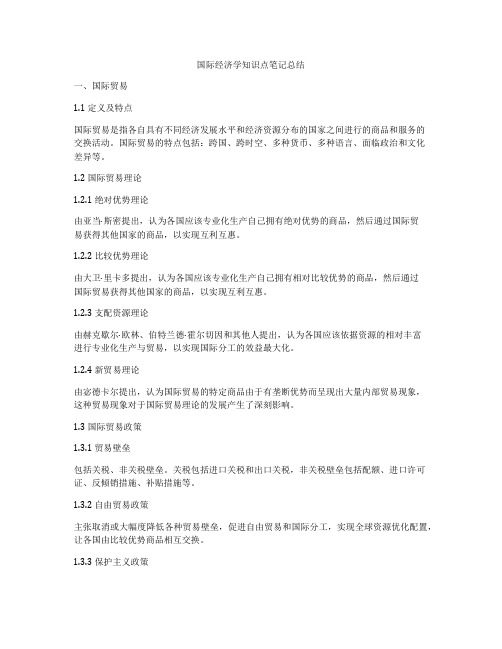
国际经济学知识点笔记总结一、国际贸易1.1 定义及特点国际贸易是指各自具有不同经济发展水平和经济资源分布的国家之间进行的商品和服务的交换活动。
国际贸易的特点包括:跨国、跨时空、多种货币、多种语言、面临政治和文化差异等。
1.2 国际贸易理论1.2.1 绝对优势理论由亚当·斯密提出,认为各国应该专业化生产自己拥有绝对优势的商品,然后通过国际贸易获得其他国家的商品,以实现互利互惠。
1.2.2 比较优势理论由大卫·里卡多提出,认为各国应该专业化生产自己拥有相对比较优势的商品,然后通过国际贸易获得其他国家的商品,以实现互利互惠。
1.2.3 支配资源理论由赫克歇尔·欧林、伯特兰德·霍尔切因和其他人提出,认为各国应该依据资源的相对丰富进行专业化生产与贸易,以实现国际分工的效益最大化。
1.2.4 新贸易理论由宓德卡尔提出,认为国际贸易的特定商品由于有垄断优势而呈现出大量内部贸易现象,这种贸易现象对于国际贸易理论的发展产生了深刻影响。
1.3 国际贸易政策1.3.1 贸易壁垒包括关税、非关税壁垒。
关税包括进口关税和出口关税,非关税壁垒包括配额、进口许可证、反倾销措施、补贴措施等。
1.3.2 自由贸易政策主张取消或大幅度降低各种贸易壁垒,促进自由贸易和国际分工,实现全球资源优化配置,让各国由比较优势商品相互交换。
1.3.3 保护主义政策主张通过设置关税、配额、进口许可证等方式,抑制外国商品对本国的进口,以保护本国产业的发展。
1.3.4 国际贸易组织包括世界贸易组织(WTO)、国际货币基金组织(IMF)和世界银行(WB)等,这些组织主要为国际贸易和金融活动提供规则和服务。
二、国际货币体系2.1 定义及特点国际货币体系是指各国之间的货币关系和国际货币交换机制的总和。
国际货币体系的特点包括:货币兑换、外汇市场和国际支付等。
2.2 国际货币体系历史2.2.1 金本位制19世纪末至20世纪初,各国货币与黄金挂钩,货币供应受限制,国际支付通过黄金结算。
克鲁格曼《国际经济学:理论与政策》(第10版)学习辅导书-第16~22章【圣才出品】
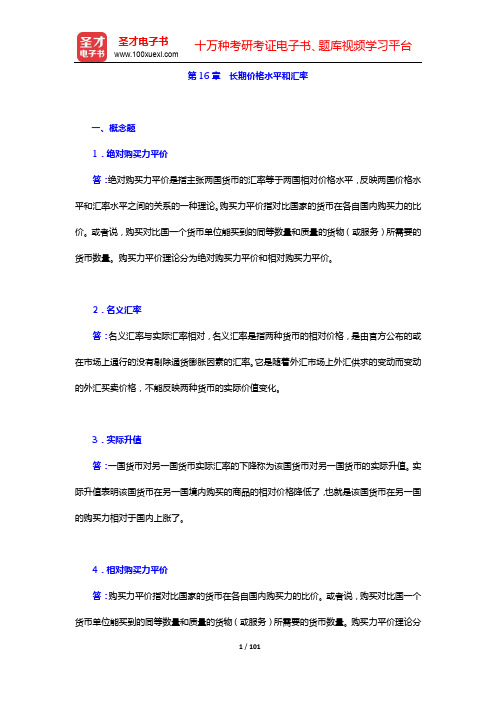
第16章长期价格水平和汇率一、概念题1.绝对购买力平价答:绝对购买力平价是指主张两国货币的汇率等于两国相对价格水平,反映两国价格水平和汇率水平之间的关系的一种理论。
购买力平价指对比国家的货币在各自国内购买力的比价。
或者说,购买对比国一个货币单位能买到的同等数量和质量的货物(或服务)所需要的货币数量。
购买力平价理论分为绝对购买力平价和相对购买力平价。
2.名义汇率答:名义汇率与实际汇率相对,名义汇率是指两种货币的相对价格,是由官方公布的或在市场上通行的没有剔除通货膨胀因素的汇率。
它是随着外汇市场上外汇供求的变动而变动的外汇买卖价格,不能反映两种货币的实际价值变化。
3.实际升值答:一国货币对另一国货币实际汇率的下降称为该国货币对另一国货币的实际升值。
实际升值表明该国货币在另一国境内购买的商品的相对价格降低了,也就是该国货币在另一国的购买力相对于国内上涨了。
4.相对购买力平价答:购买力平价指对比国家的货币在各自国内购买力的比价。
或者说,购买对比国一个货币单位能买到的同等数量和质量的货物(或服务)所需要的货币数量。
购买力平价理论分为绝对购买力平价和相对购买力平价。
其中,相对购买力平价表示在任何一段时间内,两种货币汇率变化的百分比将等于同一时期两国国内价格水平变化的百分比之差。
相对购买力平价理论认为,价格和汇率会在保持各国货币的国内购买力和国外购买力不变的情况下发生变化,反映的是价格水平变动与汇率水平变动之间的关系。
5.费雪效应答:费雪效应指通货膨胀率与利率之间的长期关系:在其他条件不变的情况下,若一国的通货膨胀率上升,最终会导致该国货币存款利率的同比例上升;同样,通货膨胀率降低最终会导致利率水平下降。
费雪效应认为,在长期中纯粹的货币增长不会对经济生活中的相对价格产生影响。
6.名义利率答:名义利率又称货币利率,与实际利率相对,是指银行挂牌执行的存款、贷款的利率。
它是以货币为标准计算出来的利率,即以货币衡量的收益率。
克鲁格曼《国际经济学:理论与政策》(第10版)学习辅导书-第9~15章【圣才出品】
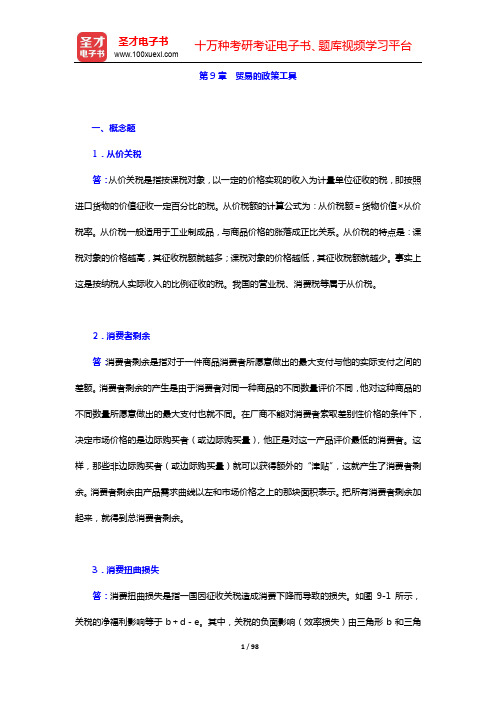
第9章贸易的政策工具一、概念题1.从价关税答:从价关税是指按课税对象,以一定的价格实现的收入为计量单位征收的税,即按照进口货物的价值征收一定百分比的税。
从价税额的计算公式为:从价税额=货物价值×从价税率。
从价税一般适用于工业制成品,与商品价格的涨落成正比关系。
从价税的特点是:课税对象的价格越高,其征收税额就越多;课税对象的价格越低,其征收税额就越少。
事实上这是按纳税人实际收入的比例征收的税。
我国的营业税、消费税等属于从价税。
2.消费者剩余答:消费者剩余是指对于一件商品消费者所愿意做出的最大支付与他的实际支付之间的差额。
消费者剩余的产生是由于消费者对同一种商品的不同数量评价不同,他对这种商品的不同数量所愿意做出的最大支付也就不同。
在厂商不能对消费者索取差别性价格的条件下,决定市场价格的是边际购买者(或边际购买量),他正是对这一产品评价最低的消费者。
这样,那些非边际购买者(或边际购买量)就可以获得额外的“津贴”,这就产生了消费者剩余。
消费者剩余由产品需求曲线以左和市场价格之上的那块面积表示。
把所有消费者剩余加起来,就得到总消费者剩余。
3.消费扭曲损失答:消费扭曲损失是指一国因征收关税造成消费下降而导致的损失。
如图9-1所示,关税的净福利影响等于b+d-e。
其中,关税的负面影响(效率损失)由三角形b和三角形d构成。
三角形b表示生产扭曲损失,这是由于关税会导致国内过多地生产该种产品造成的;三角形d表示本国的消费扭曲损失,来自于因为关税而造成的消费下降。
与这两块损失相反的是由矩形e表示的贸易条件改善所得,它来自于关税造成的外国商品出口价格的下降。
图9-1 关税的社会福利净影响4.有效保护率答:有效保护率是指整个关税制度(和有效保护措施)对某类产品在其生产过程中给予净重增值的影响,也就是由于整个关税制度而引起的国内增值的提高部分与自由贸易条件下增值部分相比的百分比。
有效保护不但注意关税对成品价格影响,也注意投入品(原材料或中间产品)由于征收关税而增加的价格,因此有效保护率计算的是某项加工工业中受全部关税制度影响而产生的增值比,是对一种产品的国内、外增值差额与其国外增值的百分比。
克鲁格曼《国际经济学:理论与政策》(第10版)学习辅导书-第1~8章【圣才出品】
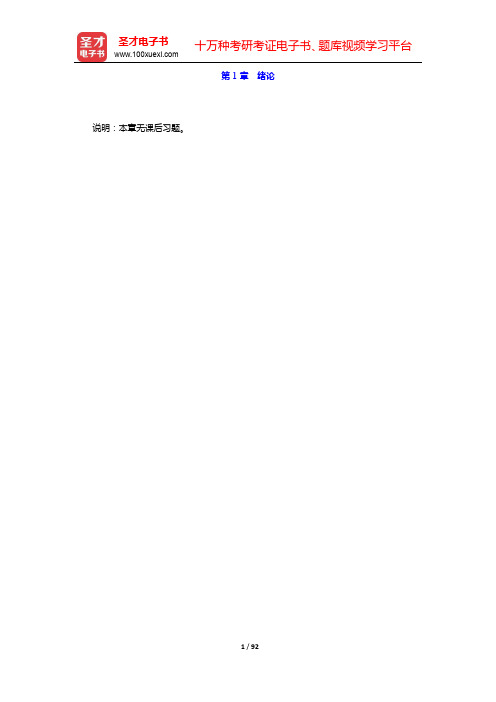
第1章绪论说明:本章无课后习题。
第2章世界贸易概览一、概念题1.发展中国家答:发展中国家是指与发达国家相对的经济上比较落后的国家,又称“欠发达国家”或“落后国家”。
发展中国家的评价标准主要是这个国家的人均国内生产总值(人均GDP)相对比较低,通常是指第三世界国家,包括亚洲、非洲、拉丁美洲及其他地区的130多个国家,占世界陆地面积和总人口的70%以上。
发展中国家地域辽阔,人口众多,有广大的市场和丰富的自然资源。
还有许多战略要地,无论从经济、贸易上,还是从军事上,都占有举足轻重的战略地位。
2.引力模型答:引力模型是用来表示两个经济体之间的贸易量与两经济体的GDP和距离以及其他因素的关系。
丁伯根和波伊赫能的引力模型基本表达式为:T ij=A×Y i a×Y j b/D ij c其中,T ij是i国与j国的贸易额,A为常量,Y i是i国的国内生产总值,Y j是j国的国内生产总值,D ij是两国的距离。
a、b、c三个参数是用来拟合实际的经济数据。
引力模型方程式表明:其他条件不变的情况下,两国间的贸易规模与两国的GDP成正比,与两国间的距离成反比。
3.国内生产总值答:国内生产总值是指一个国家(地区)领土范围内,本国(地区)居民和外国居民在一定时期内所生产和提供的最终使用的产品和劳务的价值,是用来度量一国境内的生产量的指标。
GDP一般通过支出法和收入法两种方法进行核算:用支出法计算的国内生产总值等于消费、投资、政府支出和净出口之和;用收入法计算的国内生产总值等于工资、利息、租金、利润、间接税以及企业转移支付和折旧之和。
与国民生产总值(GNP)的概念不同,GDP是一国范围内生产的最终产品的市场价值,因此是一个地域概念。
4.服务外包答:服务外包是指企业将其非核心的业务外包出去,利用外部最优秀的专业化团队来承接其业务,从而使其专注核心业务,达到降低成本、提高效率、增强企业核心竞争力和对环境应变能力的一种管理模式。
克鲁格曼《国际经济学》(国际金融)习题答案要点

《国际经济学》(国际金融)习题答案要点第12章 国民收入核算与国际收支国民收入核算与国际收支1、如问题所述,GNP 仅仅包括最终产品和服务的价值是为了避免重复计算的问题。
在国民收入账户中,如果进口的中间品价值从GNP 中减去,出口的中间品价值加到GNP 中,重复计算的问题将不会发生。
例如:美国分别销售钢材给日本的丰田公司和美国的通用汽车公司。
其中出售给通用公司的钢材,作为中间品其价值不被计算到美国的GNP 中。
出售给日本丰田公司的钢材,钢材价值通过丰田公司进入日本的GNP ,而最终没有进入美国的国民收入账户。
所以这部分由美国生产要素创造的中间品价值应该从日本的GNP 中减去,并加入美国的GNP 。
2、(1)等式12-2可以写成()()p CA S I TG =-+-。
美国更高的进口壁垒对私人储蓄、投资和政府赤字有比较小或没有影响。
(2)既然强制性的关税和配额对这些变量没有影响,所以贸易壁垒不能减少经常账户赤字。
不同情况对经常账户产生不同的影响。
例如,关税保护能提高被保护行业的投资,从而使经常账户恶化。
不同情况对经常账户产生不同的影响。
例如,关税保护能提高被保护行业的投资,从而使经常账户恶化。
(当然,使幼稚产业有(当然,使幼稚产业有一个设备现代化机会的关税保护是合理的。
)同时,当对投资中间品实行关税保护时,由于受保护行业成本的提高可能使该行业投资下降,从而改善经常项目。
一般地,永久性和临时性的关税保护有不同的效果。
这个问题的要点是:政策影响经常账户方式需要进行一般均衡、宏观分析。
一般均衡、宏观分析。
3、 (1)、购买德国股票反映在美国金融项目的借方。
购买德国股票反映在美国金融项目的借方。
相应地,相应地,当美国人通过他的瑞士银行账户用支票支付时,当美国人通过他的瑞士银行账户用支票支付时,因为他对瑞士请求权减少,因为他对瑞士请求权减少,故记入美国金融项目的贷方。
这是美国用一个外国资产交易另外一种外国资产的案例。
克鲁格曼国经第十版课后习题03-04

产品2的产量 PP
劳动资源配置
AA 产品2的劳动投入
产品2生产函数 Qc =Qc (K, Lc)
解答 2
产品1的相对价格, P1 /P2
• 资本供应的增加会使相对供给 曲线向右移动,使得产品1相对 价格下降
(P1 /P2 )1 (P1 /P2)2
• 因此,两国国家供给曲线原来
从产品2部门向 产品1部门转 移的劳动量
产品2部门使用 的劳动, LF
解答 3
产品1的相对价格, P1 /P2
(P1 /P2 )F (P1 /P2 )W (P1 /P2 )D
• 贸易导致世界价格的趋同
• 本国会出口产品1,进口产品2
RSF
RSWORLD
• 贸易会使出口部门的产品价格上 升,从而提高本国资本的收益,
问题
1. 说明本国资本供给的增加对于其生产可能性边界的影响 2. 在同一幅图上画出本国和外国的相对供给曲线 3. 如果两国国家开放贸易,会是什么模式?说明贸易对两个国家
三种要素的影响
解答 1
产品1生产函数 QF ‘=QF’(K, LF) QF =QF(K, LF)
产品1的劳动投入
产品1产量
其它条件不变,资本存量的 增加会是生产可能性边界扩 张,产品1产量增加
a 本来就在外国工作的工人
b 外国的土地所有者
c 留守本国的工人
d 本国的土地所有者
e 进行移民的2名工人
解答 1
• 工人工资等于其边际产量。本国劳动投入11,Wh=10;外国劳动投入3, Wf=18. 外国工资高,本国工资低,本国劳动力会向外国流动,直到两国工资 相等为止—结果,本国会有4个工人流出,剩下7个工人,外国3+4=7个工人, 这时两国工资率相等,Wh=Wf=14
- 1、下载文档前请自行甄别文档内容的完整性,平台不提供额外的编辑、内容补充、找答案等附加服务。
- 2、"仅部分预览"的文档,不可在线预览部分如存在完整性等问题,可反馈申请退款(可完整预览的文档不适用该条件!)。
- 3、如文档侵犯您的权益,请联系客服反馈,我们会尽快为您处理(人工客服工作时间:9:00-18:30)。
《国际经济学》(第10版)保罗·R·克鲁格曼重点笔记第三章劳动生产率与比较优势:李嘉图模型1.机会成本:利用一定资源或时间生产一种商品时,而失去的利用这些资源生产其他最佳替代品的机会。
2.比较优势:如果一个国家在本国生产一种产品的机会成本(用其他产品来衡量)低于在其他国家生产该种产品的机会成本,则这个国家在生产该种产品上就具有比较优势。
比较优势和国际贸易的基本原理:如果每个国家都出口本国具有比较优势的商品,则两国之间的贸易能使两国都受益。
英国经济学家大卫·李嘉图提出的国际贸易模型。
他指出,国际劳动生产率的不同是国际贸易的唯一决定因素。
该理论被称为李嘉图模型。
3.单一要素经济单位产品劳动投入(a):生产率的倒数,用来表示劳动生产率。
L生产可能性边界(PPF):一个国家的资源是有限的,它所能生产的产品也是有限的,因此就存在着产品替代的问题:多生产一种产品就意味着要牺牲另一种产品的产量。
一个经济体的生产可能性边界(PPF)显示了其固定数量资源所能生产的商品的最大数量。
本国资源对产出的限制:aQ + aQ ≤ L WLWLCC(斜率的绝对值等于横轴商品的机会成本)奶酪的机会成本k= - a /a = (a – /a )Q ,Q = L/a LWCLCLWLCWLW相对价格与供给而劳奶酪和葡萄酒的供给是由劳动力的流向决定的,简化模型中,劳动是唯一的生产要素,等工资率单一要素模型中不存在利润,奶酪部门每小时的动力总会流向工资比较高的部门。
/a。
,葡萄酒部门每小时的工资率等于小时内创造的价值P/aP于一个工人在1LWWCLC < /P时,奶酪部门的工资率就比较高,该国会专业化生产奶酪;当 > a/aP当P /P WLC CLWWC/a = aP /P/aa时,葡萄酒部门的工资率就比较高,该国会专业化生产葡萄酒;当LWCLC LC WLW时,该国会生产奶酪和葡萄酒两种产品。
该国价格与生产之间关系的关键命题:当一个国家的奶酪的相对价格高于它的机会成本时,就专门生产奶酪;当奶酪的相对价格低于它的机会成本时,该国就专门生产葡萄酒。
a = /P如:在没有国际贸易时,产品的相对价格等于它们的相对单位产品劳动投入。
P LC CW /a LW 4.单一要素世界中的贸易我们就说当一个国家能够以少于其他国家的劳动投入生产出同样单位的商品时,:绝对优势**aaaa < < 和该国在生产这种商品上具有绝对优势。
如:LWLCLCLW****/a/ aaaa/aa/a本国在生产奶酪上具有比较优势:或 < < LW LCLW LCLCLCLW LW**/a/aaa,外国奶酪的相对价格为。
如果没有国际贸易,本国奶酪的相对价格为LW LWLCLC将奶酪从本国运到外国或将葡萄酒一旦进行国际贸易,因为外国奶酪的相对价格比本国高,外国将出口足够的葡本国将出口足够的奶酪,从外国运到本国就是有利可图的生意。
最终,萄酒,从而使得两国商品的相对价格相等。
(使用一般均衡分析而非局部均衡分析)?国际贸易发生后相对价格的确定一种贸易产品对另一种产品的相对价格停留在贸易前两国的一般来说,国际贸易的结果是,相对价格趋于聚敛的效应是各国都只专业化生产单位产品劳动投入相对较低相对价格之间。
的产品。
贸易所得本国可以用加仑葡萄酒;另一方面,1小时劳动生产1/a验证方法1:一方面,本国可以用LW/PP交换条件是1磅奶酪交换1小时劳动生产1/a磅奶酪,并出口这些奶酪来换取葡萄酒,P/P小时劳动就可以生产(1/a)/(1加仑葡萄酒,这样,WCLC成立,则出口奶WLCC)加仑葡萄酒。
酪间接生产的葡萄酒 >a P/P/a))1/a/(P/P>1/a 或只要条件:(LWLWCCLCWWLC小时劳动直接生产的葡萄酒要多。
就比1 。
>a而在世界市场均衡时,如果没有一个国家同时生产两种产品,就一定有P/P/a LWWCLC同样,外国也可以通过生产并出口葡萄酒来换取奶酪的方式更高效地“生产”奶酪。
故两国均可以从贸易中获利。
:贸易前,消费可能性边界与生产可能性边界是一致的。
而一旦国际贸易发生,2验证方法因此也贸易都扩大了消费选择的范围,各国便可以消费与其产出不同的产品组合。
在两国,必将提高各国居民的福利水平。
相对工资一国工人的相对工资是指该国工人每小时的工资与外国工人每小时工资的比值。
正因为相对工资率位于相对生产率工资率位于两国的两个工业部门的相对劳动生产率之间。
之间,两国才各自在一种产品上具有成本优势。
高工资可以被高生产率抵消,低生产率可以被低工资所抵消。
.5.对比较优势的误解(1)生产率和竞争力:只有当一个国家的生产率达到足以在国际竞争中立足的水平时,它才能从自由贸易中获益。
×一个产业的绝对生产率优势既不是产生竞争优势的必要条件,也不是充分条件:一个产业的竞争优势不仅取决于该部门相对于别国同一部门的生产率,也取决于本国相对于外国的工资率。
(2)贫民劳动论:如果来自外国的竞争建立在低工资的基础上,那么这种竞争就是不公平的,而且会损害其他参与竞争的国家。
×外国的低工资率与本国是否从贸易中获利的问题并无关系。
对本国来说,关键的事实只是:用本国自己的劳动力来衡量,本国生产奶酪换取葡萄酒比直接生产葡萄酒更便宜。
这样的贸易对本国来说是有益的。
(3)剥削:如果一个国家的工人比其他国家工人的工资低很多,那么贸易就会使得这个国家受到剥削并使其福利恶化。
×除非有更好的选择方案,否则就不能说低工资下的贸易意味着剥削。
第四章特定要素与收入分配1.国际贸易对收入分配有着巨大的影响,其原因有两个:①作为贸易的短期结果,资源从一个部门向另一个部门的转移不可能立即实现,也不可能毫无成本地进行;②各产业对生产要素的需求有所不同。
一国所生产的产品结构的转换将自然而然地减少对某些生产要素的需求,同时增加对另外一些生产要素的需求,即贸易的长期影响。
2.特定要素模型特定要素模型由保罗·萨缪尔森和罗纳德·琼斯创建发展的。
它假定一个国家生产两种产品,劳动供给可以在两个部门之间进行分配。
与李嘉图模型不同的是,特定要素模型允许劳动以外的其他生产要素的存在。
劳动可以在部门之间进行流动,是一种流动要素,其他要素则是特定的,即只能被用于生产某些特定产品。
3.模型的假设一个国家能生产两种商品:棉布和粮食。
三种生产要素:劳动(L)、资本(K)和土地(T)。
生产棉布需要投入K和L,生产粮食需要投入T和L。
QQKL)= , 棉布的生产函数:(CCC(Qc表示棉布的产出;K表示资本存量;Lc表示棉布生产中所雇用的劳动力)QQTL)粮食的生产函数:, = (FF F(Q表示粮食的产出,T表示土地的供给量;L表示粮食生产中所雇用的劳动力)FF对于国家整体来说,各部门投入的劳动之和一定等于总的劳动供给量L,即L+L=L 生产可能性FC4.棉布的生产函数劳动的边际产量(即生产函数的斜率)生产函数的形状反应了边际收益递减效应,即如果只增加劳动投入而不增加资本投入,增加一个工人就意味着减少每个工人所操作的资本量,因此每一单位相继增加的劳动所带来的产量增加都比前一单位要少。
特定要素模型中的生产可能性边界;第二象限:粮食的生产函数;第三象限:一国的PP)第一象限:一国的生产可能性边界();第四象限:棉布的生产函数。
劳动资源分配(AA 在李嘉图模型中,劳动是唯一的生产要素,生产可能性边界是一条直线。
PP曲线PP在特定要素模型中,其他生产要素的加入使得生产可能性边界变成了一条曲线。
的弯曲反映了在各部门中都存在着劳动的边际收益递减规律。
边际收益递减规律是特定要素模型和李嘉图模型的关键区别。
单位棉布的产量所必须1曲线PP的斜率即用粮食衡量的棉布的机会成本,也就是为了增加棉布部粮食部门劳动的边际产量//MPL牺牲的粮食产量为:生产可能性曲线的斜率=-MPL=-CF门劳动的边际产量价格、工资与劳动配置5. 遵循利润最大化原则,雇主会雇佣劳动,直至满足:wPMPL = 在棉布部门 x CC wMPLP = 在粮食部门xFF.直至两个部门的工资率相由于劳动是流动要素,它将从低工资率部门向高工资率部门流动,)相等为止。
劳动在棉布和粮食两个部门的配置使得两个部门劳动的边际产量价值(P*MPL 等。
实现均衡时,工资率应与劳动的边际产量价值相等。
=w*PMPL*P=MPL FCFC PMPLMPLP/ = --/或改写为 CFFC左边是生产可能性边界在真实生产点上的斜率,右边是负的棉布相对方程。
在生产点上,生产可能性边界一定与一条斜率为负的棉布价格与粮食价格之商的直线相切。
(特定要素模型中的生产)生产可能性边界在该点的斜率等于负的某一点上进行生产,一国会在生产可能性边界(PP)的棉布相对价格。
粮食与棉布相对价格的变动,对劳动配置和收入分配的影响6. )价格同比例变化1(.同比例变化时,模型中的其他因素并不发生实际的变化。
工资率与价格以相同的PP当和FC由于各部门所雇用的所以实际工资率即工资率与产品价格之比并不受任何影响。
比例上升,总之,因此资本所有者和土地所有者的实际收入也没有变化。
劳动量不变,实际工资率不变,各方所处的情形都与价格变化之前一样。
2()相对价格的变化这一移至点2.P的上升使棉布部门的劳动需求曲线以相同的比例上移,并使均衡点从点1C(因为移动产生了两个重要结果:①工资率上升,但上升幅度比棉布价格上升的幅度要小。
劳动会从单独上升时,该部门劳动的边际产量会下降)②P随着棉布部门就业人数的增加,C粮食部门向棉布部门转移,因而棉布的产出会增加,粮食的产出会减少。
棉布价格的上升相对价格的确定棉布相对价格的变动所引起的产出变动.一国的生产点总是位于它的生产可能性边界PP上的某一点,在该点处PP的斜率等于负的棉布相对价格。
因此,P/P的增加会使得生产点沿着生产可能性边界向右下方移动,即棉布FC的产出更多了,粮食的产出更少了。
在特定要素模型中,棉布的相对价格上升会导致棉布对粮食的相对产出增加,因此,相对供给曲线RS上向上倾斜的。
曲线RS与相对需求曲线RD的交点决定了均衡的相对产出和相对价格。
相对价格的变化对收入分配的影响可以概况如下:①对相对价格上升的部门来说,特定的要素一定会收益。
②对相对价格下降的部门来说,特定的要素一定会受损。
③流动要素的福利变化不能一概而论。
7.特定要素模型中的国际贸易贸易和相对价格因为国家之间的技术不同或资源不特定要素经济的相对供给曲线和世界相对供给曲线不同,1增加至)同。
而各国的相对需求曲线不存在差别。
参与贸易使得棉布的相对价格从(P/P FC2该国消费者对由于棉布相对价格的上升,这使该国生产相对更多的棉布。
